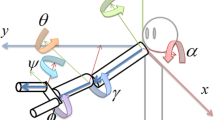Abstract
The architecture of a neural network controlling an unknown environment is presented. It is based on a randomly connected recurrent neural network from which both perception and action are simultaneously read and fed back. There are two concurrent learning rules implementing a sort of ideomotor control: (i) perception is learned along the principle that the network should predict reliably its incoming stimuli; (ii) action is learned along the principle that the prediction of the network should match a target time series. The coherent behavior of the neural network in its environment is a consequence of the interaction between the two principles. Numerical simulations show a promising performance of the approach, which can be turned into a local and better “biologically plausible” algorithm.










Similar content being viewed by others
References
Adams RA, Shipp S, Friston KJ (2013) Predictions not commands: active inference in the motor system. Brain Struct Funct 218(3):611–643
Åström KJ (2006) Introduction to stochastic control theory. Courier Dover Publications, New York
Åström KJ, Hägglund T (2006) Advanced PID control. ISA-The Instrumentation, Systems, and Automation Society, Research Triangle Park
Bishop CM (1995) Neural networks for pattern recognition. Oxford University Press, Oxford
Butler AB, Hodos W (2005) Comparative vertebrate neuroanatomy: evolution and adaptation. Wiley, New York
Chow TW, Fang Y (1998) A recurrent neural-network-based real-time learning control strategy applying to nonlinear systems with unknown dynamics. IEEE Trans Ind Electron 45(1):151–161
Conant RC, Ashby W (1970) Every good regulator of a system must be a model of that system. Int J Syst Sci 1(2):89–97
Doya K (1993) Bifurcations of recurrent neural networks in gradient descent learning. IEEE Trans Neural Netw 1:75–80
Ecker AS, Berens P, Keliris GA, Bethge M, Logothetis NK, Tolias AS (2010) Decorrelated neuronal firing in cortical microcircuits. Science 327(5965):584–587
Farhang-Boroujeny B (1998) Adaptive filters: theory and applications. Wiley, New York
Fortmann TE, Hitz KL (1977) An introduction to linear control systems. CRC Press, Boca Raton
Friston KJ, Daunizeau J, Kilner J, Kiebel SJ (2010) Action and behavior: a free-energy formulation. Biol Cybern 102(3):227–260
Gálvez-Carrillo M, De Keyser R, Ionescu C (2009) Nonlinear predictive control with dead-time compensator: application to a solar power plant. Solar Energy 83(5):743–752
Ge S, Hang CC, Lee TH, Zhang T (2010) Stable adaptive neural network control. Springer, New York
Ge SS, Yang C, Lee TH (2008) Adaptive predictive control using neural network for a class of pure-feedback systems in discrete time. IEEE Trans Neural Netw 19(9):1599–1614
Gerstner W, Kistler WM (2002) Mathematical formulations of hebbian learning. Biol Cybern 87(5–6):404–415
Greenwald AG (1970) Sensory feedback mechanisms in performance control: with special reference to the ideo-motor mechanism. Psychol Rev 77(2):73
Gunnarsson S (1996) Combining tracking and regularization in recursive least squares identification. In: IEEE Conference on Decision and Control, vol 3, pp 2551–2552. Citeseer
Haykin SO (2014) Adaptive filter theory, 5th edn. Pearson Education. http://www.pearsonhighered.com/educator/product/Adaptive-Filter-Theory/9780132671453.page
Jaeger H (2001) The “echo state”approach to analysing and training recurrent neural networks-with an erratum note. Bonn, Germany: German National Research Center for Information Technology GMD Technical Report 148:34
Jaeger H, Haas H (2004) Harnessing nonlinearity: predicting chaotic systems and saving energy in wireless communication. Science 304(5667):78–80
Jaeger H, Lukosevicius M, Popovici D, Siewert U (2007) Optimization and applications of Echo State Networks with leaky-integrator neurons. Neural Netw 20(3):335–352
Jordan MI (1996) Computational aspects of motor control and motor learning. Handb Percept Action Motor Skills 2:71–118
Jordan MI, Rumelhart DE (1992) Forward models: supervised learning with a distal teacher. Cogn Sci 16(3):307–354
Kawato M, Furukawa K, Suzuki R (1987) A hierarchical neural-network model for control and learning of voluntary movement. Biol Cybern 57(3):169–185
Kwakernaak H, Sivan R (1972) Linear optimal control systems, vol 1. Wiley, New York
Laje R, Buonomano DV (2013) Robust timing and motor patterns by taming chaos in recurrent neural networks. Nat Neurosci 16(7):925–933
Narendra KS, Parthasarathy K (1990) Identification and control of dynamical systems using neural networks. IEEE Trans Neural Netw 1(1):4–27
Pan Y, Wang J (2012) Model predictive control of unknown nonlinear dynamical systems based on recurrent neural networks. IEEE Trans Ind Electron 59(8):3089–3101
Pearlmutter BA (1995) Gradient calculations for dynamic recurrent neural networks: a survey. IEEE Trans Neural Netw 6(5):1212–1228
Prokhorov DV (2007) Training recurrent neurocontrollers for real-time applications. IEEE Trans Neural Netw 18(4):1003–1015
Renart A, de la Rocha J, Bartho P, Hollender L, Parga N, Reyes A, Harris KD (2010) The asynchronous state in cortical circuits. Science 327(5965):587–590
Seamans J, Durstewitz D (2008) Dopamine modulation. Scholarpedia 3(4):2711
Shin YK, Proctor RW, Capaldi E (2010) A review of contemporary ideomotor theory. Psychol Bull 136(6):943
Skogestad S, Postlethwaite I (2007) Multivariable feedback control: analysis and design, vol 2. Wiley, New York
Slotine J-JE, Li W et al (1991) Applied nonlinear control, vol 199. Prentice-Hall, Englewood Cliffs
Sontag ED (1997) Recurrent neural networks: Some systems-theoretic aspects. In: Karny M, Warwick K, Kurkova V (eds) Dealing with complexity: a neural network approach. Springer, London, pp 1–12
Sussillo D, Abbott LF (2009) Generating coherent patterns of activity from chaotic neural networks. Neuron 63(4):544–557
Tani J (1996) Model-based learning for mobile robot navigation from the dynamical systems perspective. IEEE Trans Syst Man Cybern Part B Cybern 26(3):421–436
Waegeman T, Wyffels F, Schrauwen B (2012) Feedback control by online learning an inverse model. IEEE Trans Neural Netw Learn Syst 23(10):1637–1648
Wang C, Hill DJ (2006) Learning from neural control. IEEE Trans Neural Netw 17(1):130–146
Yang C, Ge SS, Xiang C, Chai T, Lee TH (2008) Output feedback nn control for two classes of discrete-time systems with unknown control directions in a unified approach. IEEE Trans Neural Netw 19(11):1873–1886
Zhong-Sheng H (2006) On model-free adaptive control: the state of the art and perspective. Control Theory Appl 4:018
Acknowledgments
I thank Herbert Jaeger, Michael Thon, Jochen Steil, Felix Reinhart, and Benjamin Schrauwen for helpful discussions. I was funded by the European project AMARSI.
Author information
Authors and Affiliations
Corresponding author
Rights and permissions
About this article
Cite this article
Galtier, M. Ideomotor feedback control in a recurrent neural network. Biol Cybern 109, 363–375 (2015). https://doi.org/10.1007/s00422-015-0648-4
Received:
Accepted:
Published:
Issue Date:
DOI: https://doi.org/10.1007/s00422-015-0648-4




